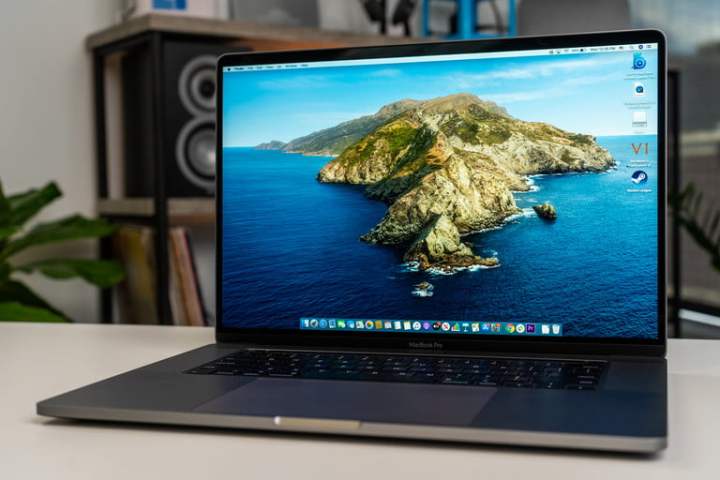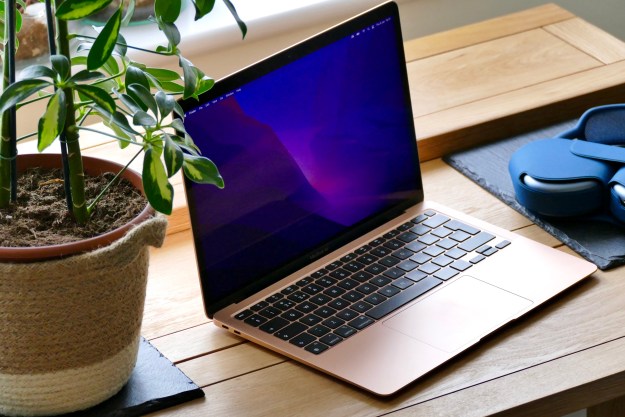Apple’s MacBook has long been viewed as the go-to laptop for students, designers, and those in the creative industry, but Dell’s XPS lineup doesn’t lag far behind.
With the introduction of the XPS 17, the XPS lineup has its sights set on Apple’s high-end MacBooks. Featuring Intel’s latest 10th-gen H-Series processors and up to Nvidia’s RTX 2060 GPU, it’s one seriously powerful laptop. Here’s a look at how XPS 17 stands up against the MacBook Pro 16-inch.
Price and design

Dell’s XPS 17 starts at $1,500, and Apple’s
Meanwhile, the
Price difference aside, both of these
Dell’s XPS 17 takes a lot of design cues from the rest of the XPS lineup. It is cut from a block of aluminum in two pieces and features diamond-cut sidewalls. There’s also aerospace-inspired carbon fiber used in the design of the black palm rest. It comes in at 0.77 inches in thickness and weighs 4.65 pounds. There’s only one interior color option: Classic black.
In terms of weight and thickness, Apple’s MacBook is slimmer than Dell’s XPS 17, mainly because of the smaller 16-inch screen. It comes in at 0.64 inches in thickness, and 4.3 pounds. That’s a subtle difference you’re not likely to notice unless you’re picky.

The XPS 17 sports four Thunderbolt 3 ports, a full-size SD card reader, and a 3.5 mm headphone jack. It is a very well-connected modern machine, though there is no USB-A, as there has been in previous XPS
The MacBook has the Touch Bar, which isn’t on the XPS 17. This OLED strip gives you access to function keys and other shortcuts in MacOS via touch. Both
Display

The signature feature of Dell’s modern XPS
Dell claims the display on the XPS 17 has a 93.7% screen-to-body ratio. It also comes in at the 16:10 aspect ratio, which allows for a bit more vertical room when multitasking. Screen options include a
If you’re looking at the display on the
Specs-wise, the
Apple’s MacBook also has the same 500 nits of brightness as the XPS 17, but it sports support for Apple’s P3 Wide color gamut and true-tone technology, which can adjust the color temperature of the screen based on how you use it. Both are fantastic devices for photography, graphic design, and video editing thanks to the fantastic color accuracy.
Performance and battery life

Of course, performance is key for
With the XPS 17, Dell has opted for Intel’s latest 10th Generation H-Series processors. There are options for either 4-core, 6-core, or 8-core processors. That includes the Core i5-10300H, Core i7-10750H, Core i7-10875H, and the Core i9-10885H.
Apple, meanwhile, opts for a 2.6GHz 6‑core Intel Core i7 processor or a 2.3GHz 8‑core Intel Core i9 processor. Configurations can be pushed up to s 2.4GHz 8‑core Intel Core i9, with Turbo Boost of up to 5.0GHz.
Storage starts at 512GB but can be increased to as much as 8TB if needed.

In the GPU department, Apple offers options for the AMD Radeon Pro 5500M with either 4GB or 8GB of GDDR6 memory. These AMD parts are all custom chips designed for Apple’s devices. Based on AMD’s next generation of Zen 2 7nm graphics architecture, we found these GPUs help make the MacBook a video-editing workhorse, with the ability to complete a video in 4 minutes, twice as fast as last year’s MacBook Pro 15-inch.
With the XPS, Dell has gone with Nvidia, which provides a lot more choice. Base models come with options for Intel’s UHD graphics. There’s also the GTX 1660 Ti with 4GB of GDDR6 memory as a midrange option or the powerful RTX 2060 graphics card with 6GB of GDDR6 memory.
We didn’t test it yet, but the model with RTX graphics can also be a workhorse. It will be able to take advantage of ray tracing and dedicated A.I. cores. Dell also says it has tweaked the thermals to ensure the laptop can keep up. It delivers 90 watts of power in a thin form factor.
On models with Nvidia graphics, the XPS 17 has dual-opposite outlet fans to increase fan airflow by approximately 30% and drive cooling airflow in both directions. There’s also a massive vapor chamber that spans the entire width of the laptop to keep the processor cool.
Battery life is currently an unknown for the XPS 17. Apple’s MacBook lasted around five-and-a-half-half hours with general usage. That’s thanks to the 16% larger 100‑watt‑hour battery. Dell’s XPS 17 has options for either a 97 watt-hour or 56-watt hour battery.
Keyboard, touchpad, and audio

The keyboard, touchpad, and audio experience are important aspects of any laptop. In these areas, the XPS 17 and the MacBook Pro do not disappoint. Apple makes up for its issue from the past with its Magic Keyboard, and Dell has supersized its keyboard to help make the XPS lineup great.
Looking at the XPS 17 keyboard, it has something its younger sibling, the XPS 13, does not. Instead of sporting an edge-to-edge keyboard, the keyboard is in the middle of the laptop on the XPS 17, surrounded by speaker grills. The keycaps are also much larger than before, and there is the addition of larger left and right arrow keys. As for the touchpad, it is much larger than the ones found on the XPS 13 and XPS 15. It’s also centered right in the middle for ease of access and to guard against accidental clicks when resting your hands on the palm rest.
The speakers on the XPS 17 are upward-firing, like on Apple’s MacBook, and are tuned by the Waves Nx 3D audio experience. There are also two tweeters in the base for a truly immersive quad-speaker setup.

As mentioned, you’ll find the newly improved “Magic Keyboard” on the MacBook Pro 16. This keyboard moves away from Apple’s controversial butterfly switch mechanism over to the classic scissor one instead. It also has an inverted T-arrangement for the arrow keys and a physical escape key. We found it was one of the best ever released, with larger keycaps and a snappier feeling.
Of course, this keyboard is flanked by Apple’s Force Touch trackpad on the bottom. This is different from the XPS 17 since there isn’t a dedicated area to do your clicking. The entire surface allows you to click anywhere and offers haptic feedback that provides a responsive and uniform feel.
Apple’s MacBook also features impressive speakers. It has a high‑fidelity six‑speaker system with force-canceling woofers. It has two more speakers than the XPS 17 and support for wide stereo sound. If audio is important for you, then the MacBook might be the way to go, though until we test the XPS 17, we can’t say for sure.
The XPS wins — on paper, that is
Looking at just the specs, the XPS 17 is the winner of this battle of the
Editors' Recommendations
- The XPS 16 is fighting an uphill battle against the MacBook Pro
- MacBook Pro 16 vs. MacBook Pro 14: The important differences
- The best MacBook to buy in 2024
- Best refurbished MacBook deals: Get a MacBook Air for $140 and more
- Best laptop deals: Save on the Dell XPS 14, MacBook Pro 16 and more


